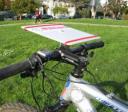AR Navigation Supplies Rotating Map Holder
AR Nav Supplies Rotating Map Holder ($55.00)
When I was first honing my skills as a navigator I was impressed when I attended my first bike orienteering event that virtually all of the top navigators were using map boards on their bikes. I quickly invested in the $100 Axis map board. Although the Axis map board had many good features, and was well constructed, it has a significant flaw (beyond the price)àmounting took around 7 to 10 minutes. The made it impractical to quickly remove when facing technical downhill (itÆs nice to actually see your front tire sometimes!) or handing the board to a buddy. Bike whacking was no joy either.
Recently, AR Navigation Supplies released their own design for a map board. At initial glance, the AR Nav map holder is similar in design to the Axis board, however, the cost is half of that of the Axis board. Mounting is done via a quick release clip, allowing mounting in a few seconds. The overall weight of the board is less than the Axis as well.
The size of the AR Nav supply board is 9ö x 9ö, the same as my original Axis board. (AR Nav also sells a map board that does not rotate featuring an 8.5ö x 10.5ö face). I think many peopleÆs initial reaction is that the board is too small. That was my first reaction years ago when I bought my Axis board. So I took action and replaced the 9×9 Axis map board with a homemade 12×12 board. After a few weeks, it was clear my 12×12 board was too big, both obstructing everything else on my bars, and also obstructing more of my view than I felt comfortable riding with in steep technical terrain. After fiddling with smaller and smaller boards, I ended up with the original 9×9ö board.
The Axis board, which featured a clear plastic covering that was attached to the bottom side of the map board via velcro. In contrast, the AR Nav supply board features a simple bungie cord system that holds your map in place. This system is designed to work with your own map case — you simply position your map case under the bungies. This provides two advantages. First, you don’t need to remove your map from its case when transitioning from a trek or kayak to the bike. Second, you don’t need to spend as much time fiddling to get your map to fit in the 9×9 Axis window. Instead, you simply fold your map case to fit under the bungies.
More good news…if you want to see more than a 9 inch window, most waterproof map cases can be positioned to extend beyond the map board, resulting in as large a viewing area as you feel comfortable with. While I find this set up preferable to the Axis board design, my teammate Lou prefers the Axis setup…in part, because the platic covering of the Axis board tends to be clearer and less scratched than a typical map case. He replaced his AR Nav face board with his old Axis board, getting the best of both worlds. Anyone interested in this approach could also easily modify the AR nav board to have a similar covering, for the cost of a few strips of velcro and some clear plastic.
Bottom line: Most multi day adventure racer navigators are using map boards, and IÆd be surprised if the AR Nav Board isnÆt the overwhelming choice for navigators in the years to come. The design is strong, and the price is half of competing offerings. AR Navigation Supplies has been raising the bar for affordable and effective navigation tools, and the rotating map board is a centerpiece of their offerings.
Last 5 posts by John
- All are in safe and sound... - July 2nd, 2008
- Our friends making it across the finish line... - July 1st, 2008
- Featured Bay Area teams - July 1st, 2008


